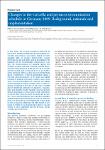Changes to the varicella and pertussis immunisation schedule in Germany 2009: Background, rationale and implementation
Wiese-Posselt, Miriam
Hellenbrand, Wiebke
In July 2009, the German Standing Committee on Vaccination (STIKO) modified its recommendations for varicella and pertussis vaccination, based on newly available data on disease epidemiology, vaccine effectiveness (VE) and safety, and an evaluation of the feasibility of the recommended immunisation strategy. The recommendation for varicella vaccine now includes a routine two-dose schedule with the administration of the first dose at the age of 11 to 14 months and the second dose at the age of 15 to 23 months, with a minimum interval of four weeks between these doses. Furthermore, STIKO recommended adding a one-time pertussis booster to the adult vaccination schedule to expand the cocoon strategy in place since 2004. The recommendation of a booster vaccination with an acellular pertussis vaccine every 10 years for persons employed in the care of pre-school children and for healthcare personnel in paediatric, gynaecologic and obstetric health facilities was extended to persons employed in schools and in other institutions caring for older children, and to all healthcare personnel. These recommendations were based on available epidemiological data showing an increase in incidence from 7-10 cases per 100,000 inhabitants in 2002-2004 to over 30 by 2007. Moreover, the high burden of pertussis in infants at 94 hospitalised cases per 100,000 infants in 2007 suggested that the previous cocoon strategy was insufficient.
No license information

